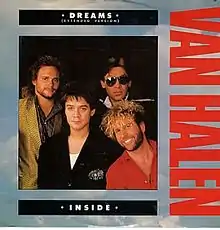Dreams (Van Halen song)
"Dreams" is a song by Van Halen released in 1986 from the album 5150. It was the second single from that album, and it reached number 22 on the Billboard Hot 100 chart that year. It was released in 7" and 12" single formats, the 7" single featuring the album version and the 12" featuring a slightly extended one. Nine years after its original release, "Dreams" introduced the band to a new generation of fans when it appeared in Mighty Morphin Power Rangers: The Movie and on its soundtrack album.
| "Dreams" | ||||
|---|---|---|---|---|
 | ||||
| Single by Van Halen | ||||
| from the album 5150 | ||||
| B-side | "Inside" | |||
| Released | May 24, 1986 | |||
| Recorded | 5150 Studios, Hollywood, California, 1985–1986 | |||
| Genre | Synth rock, hard rock | |||
| Length | 4:20 (7" edit) 4:53 (7") 5:07 (12") | |||
| Label | Warner Bros. | |||
| Songwriter(s) | Sammy Hagar, Eddie Van Halen, Alex Van Halen & Michael Anthony | |||
| Van Halen singles chronology | ||||
| ||||
Chuck Klosterman of Vulture.com ranked it the 38th-best Van Halen song, saying that it had a "good vocal performance, an okay message about dreaming."[1]
Background
"Dreams" was written during the Sammy Hagar era of the band. It was performed during most tours featuring Hagar, including the most recent Hagar reunion tour. Even the Gary Cherone-headed tour supporting Van Halen III featured the song in their set-list. The song was also used to close the 2004 Democratic National Convention, played after the acceptance speech of John Kerry. It was also used as the campaign's theme song at rallies across the country in 2004. During an interview with Hagar for Rolling Stone featuring questions from fans, Hagar said that "Dreams," along with "Right Now" were his favorite Van Halen songs, with "Dreams" being his most favorite if you pushed him. The song has also been redone by Hagar by his solo band, becoming a slower, more contemplative song, performed acoustically instead of the original album's faster paced rock arrangement.
Arrangements
Eddie Van Halen played guitar and keyboards on the studio version of this song. During the 5150 Tour, he played the keyboards and switched to the guitar during the first solo, while Hagar played the rhythm parts before then. On later tours, he would play guitar only, while the keyboard was either played offstage by a hired performer (such as Alan Fitzgerald of Night Ranger during the For Unlawful Carnal Knowledge Tour), or prerecorded material was used.
During live performances, on the chorus "We'll get higher and higher, straight up we'll climb. Higher and higher, leave it all behind", bassist Michael Anthony usually sang the second "higher" in both parts. On the studio version, Sammy Hagar sings them both. This became a standard part of the song's live performances and Eddie Van Halen would also join in the singing.
Of the album version, producer Mick Jones said: "I was able to push Sammy to new heights – literally. He was singing so high that he was hyperventilating. He almost passed out."[2]
Music videos
There were three music videos made for the song. The most well known version was shot in 1986 and featured the US Navy's Blue Angels performing a variety of aerial stunts with the Douglas A-4 Skyhawk. The other two videos were shot in March 1993 from a live performance at the Whisky a Go Go in West Hollywood, California, to celebrate the band's return to the venue after 15 years for promotion of the Live: Right Here, Right Now release. One version of the video features newscasters and interviews with fans lining up outside the venue before the performance. This version is available on Van Halen: Video Hits, Vol. 1. A second version features far less commentary and more focus on the performance itself.
Charts
| Chart (1986) | Peak position |
|---|---|
| Australia (Kent Music Report)[3] | 51 |
| Canada Top Singles (RPM)[4] | 85 |
| US Billboard Hot 100[5] | 22 |
| UK Singles Chart | 62 |
| US Top Rock Tracks (Billboard)[6] | 6 |
Personnel
References
- Klosterman, Chuck (October 6, 2020). "All 131 Van Halen Songs, Ranked From Worst to Best A look back at the band's formidable legacy". Vulture.com. Retrieved October 10, 2020.
- Elliott, Paul (March 2014). "The best of both worlds". Classic Rock. No. 194. p. 48.
- Kent, David (1993). Australian Chart Book 1970–1992 (illustrated ed.). St Ives, N.S.W.: Australian Chart Book. p. 319. ISBN 0-646-11917-6.
- "Top RPM Singles: Issue 0698." RPM. Library and Archives Canada. Retrieved January 9, 2021.
- "Van Halen Chart History (Hot 100)". Billboard. Retrieved May 10, 2016.
- "Van Halen - Chart history". Billboard. Prometheus Global Media. Retrieved May 10, 2016.